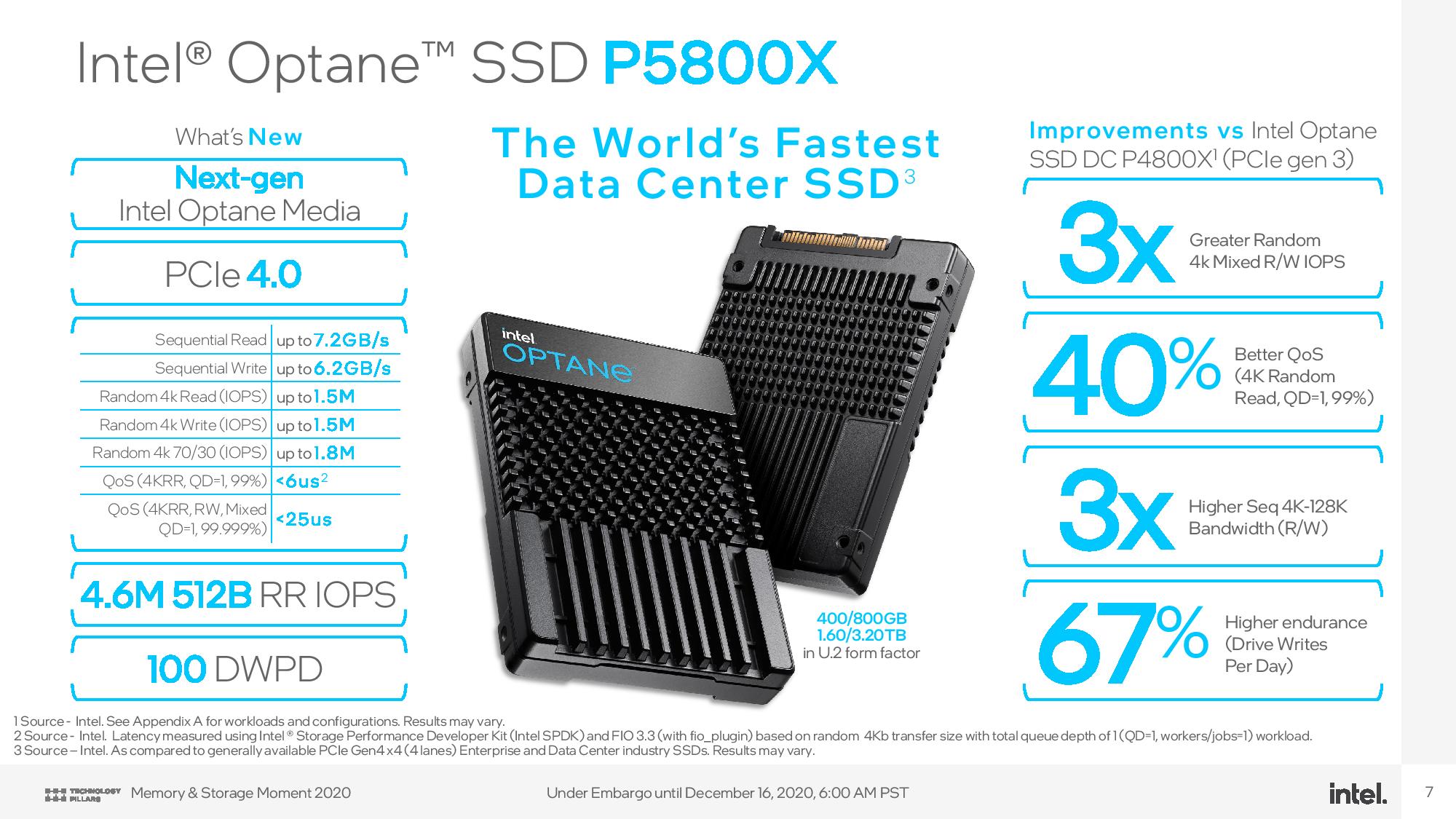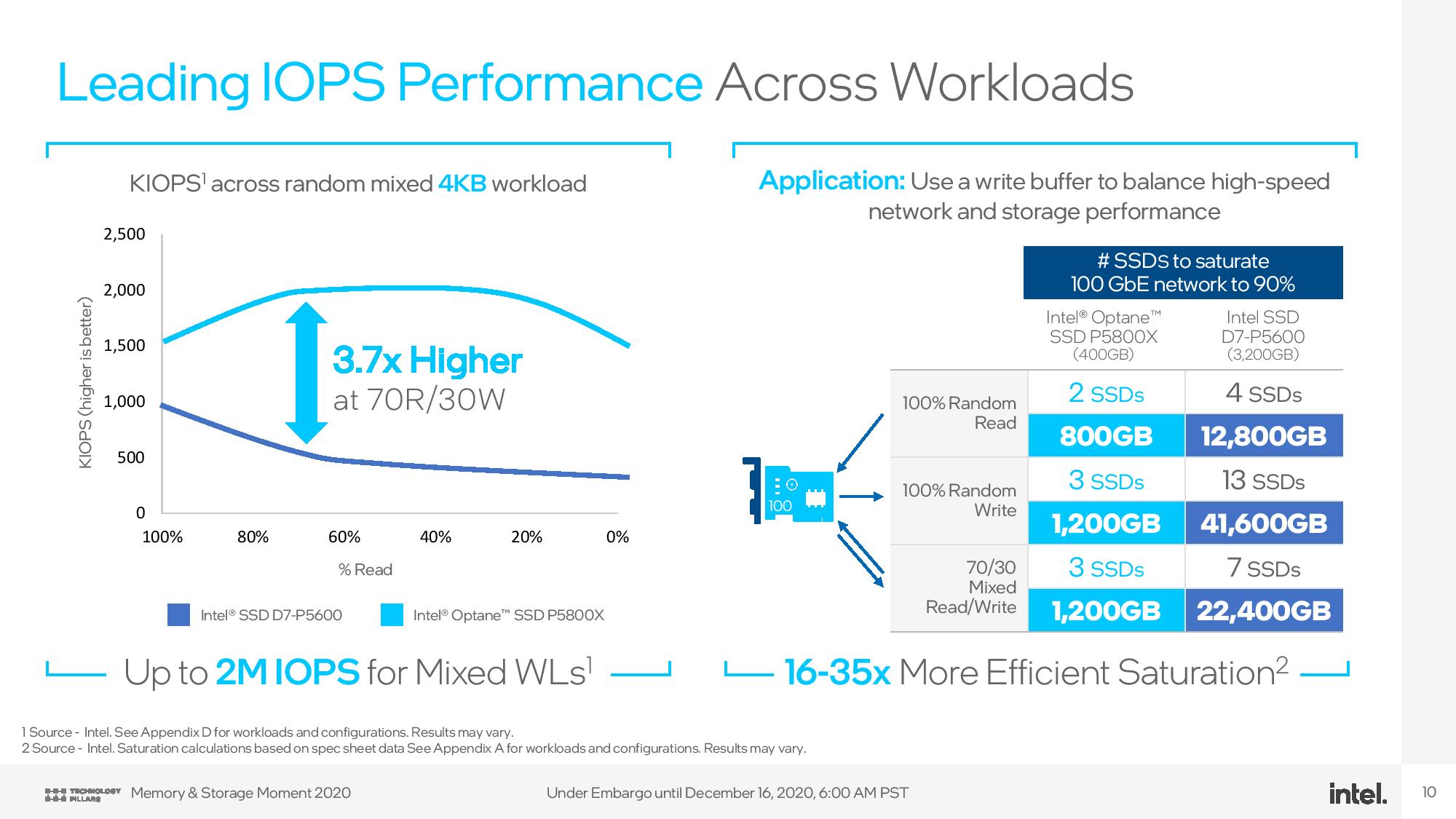Intel Debuts 'World's Fastest SSD,' the PCIe 4.0 Optane SSD P5800X
Next-Level Optane
Intel is taking Optane to the next level with its SSD P5800X, which it bills as the fastest SSD in the world. The next-gen Optane SSD leverages the PCIe 4.0 interface, second-gen Optane media, and a new SSD controller to deliver truly astounding performance and endurance specifications.
Compared to the first-gen Optane DC P4800X, Intel says the 5800X offers an impressive 3X performance improvement in random read/write workloads, peaking at 1.5 million 4K random IOPS, and 3X more sequential performance at a peak of 7.2 GB/s.
The drive also delivers up to 4.6 million IOPS in random 512B workloads (useful for certain types of caching workloads) and up to 1.8 million IOPS in mixed workloads.
Additionally, the drive offers up to 67% more write endurance than the first-gen P4800X, and now peaks at a staggering 100 drive writes per day (DWPD). That also makes it the most endurant SSD on the market. For perspective, there are very few 'regular' NAND-based SSDs that offer even 10DWPD of endurance, meaning the P5800X is truly in a class of its own.
If Intel follows its standard practice, we should see consumer variants of these SSDs come to market, let's see what performance looks like.




The drive leverages Intel's second-gen Optane media, which comes with two decks/layers instead of one, and a new PCIe 4.0 x4 SSD controller that allows the company to finally break the shackles of the PCIe 3.0 interface.
Intel isn't sharing the finer-grained technical specifications behind the P5800X's new PCIe 4.0 SSD controller. Still, we know that the drives will come in the tried-and-true U.2 form factor in capacities of 400GB, 800GB, 1.6TB, and 3.2TB, marking a healthy capacity increase that is more than twice the storage of the previous-gen DC P4800X.
Get Tom's Hardware's best news and in-depth reviews, straight to your inbox.
Just like any other Optane-powered drive, the exotic underlying 3D XPoint technology provides far more speed and endurance than any NAND-based SSD, delivering a level of performance that lands between flash SSDs and system memory. The drives are also designed to offer a superior quality of service (QoS) over competing NAND-based SSDs, meaning performance consistency is a key focus area. Intel's first-gen P4800X had already established itself as the most consistent SSD on the market, but Intel says the P5800X extends that with up to a 40% better QoS in 4K random read workloads.


Perhaps one of the most valuable aspects of an Optane SSD is its ability to deliver tremendously consistent performance even while it is under heavy load. As outlined in the slide above, the P5800X reaches new heights with more than 8 GB/s of throughput while under heavy load, easily outclassing all NAND-based SSDs on this logarithmic scale and also notching a substantial lead over its previous-gen counterpart. Intel claims the drive can deliver less than 66us of 99.999th percentile latency, which is a massive step forward over the first-gen DC P4800X, not to mention standard SSDs.





The Optane Memory P5800X can even outstrip what we typically classify as the throughput limit of the PCIe 4.0 bus. That comes as a byproduct of the drive's ability to leverage PCIe's bi-directional interface. By saturating both sides of the interface at full line-rate read and write performance, the drive delivers even higher performance during mixed workloads. We can see that ability in the 70/30 read/write workload outlined above where the SSD peaked at 2 million IOPS. This allows the drive to deliver 3.7x more performance than the previous-gen model in mixed random workloads.
Intel hasn't released pricing information yet, but the company says the drives are already shipping to OEM companies. Naturally, as a standards-based NVMe block-addressable device, these SSDs will also be compatible with AMD's EPYC processors.
On the other end of the performance spectrum, Intel also announced new QLC SSDs today, along with its plans to debut 5-bit-per-cell PLC flash, a first, in the near future. You can read about that here.

Paul Alcorn is the Editor-in-Chief for Tom's Hardware US. He also writes news and reviews on CPUs, storage, and enterprise hardware.
-
rluker5 I picked up the 900p when it came out. Random 4k read tested about 1/5 as fast as a ramdisk in crystaldiskmark and 5x as fast as fastest nand. The ramdisk theoretically should have been faster, maybe my cpu is holding it back - 2400c10, 5775c oc. Also the filesystem (which will hopefully start to get bypassed more by stuff like directstorage) is leashing drive performance to cpu performance. I don't see that much of a difference over sata nand in everyday tasks.Reply
This new drive will be even closer to ramdisk in performance. And until modern software takes advantage of it, you will notice the improvement in everyday tasks even less. I hope directstorage comes with an optane setting. -
cirdecus I've had a similar experience, although I can tell there's a difference with daily tasks. I have the 905p 1.5TB now and just replaced a set of PCIe 4.0 Sabrent rockt m.2's in a RAID0. It feels like night and day honestly. I was shocked. This has to be the future of storage. I'm still using the m.2 drives for other shared media storage, but in terms of applications and games, this is amazing tech.Reply -
Jim90 Would love to see QD1 (much, much more significant to the average user) being brought down significantly across all manufacturers. Optane is an improvement, but a damn expensive one.Reply -
cyrusfox Reply
Its a media limitation NAND vs Optane and nothing NAND can do to bridge that (See Samsung ZNAND if you want to see the best NAND can do). I hear NAND backed with sufficient DRAM Tier may be able to simulate Optane performance, but would not have the endurance, but if that could be done cheap enough, likely doesn't matter.Jim90 said:Would love to see QD1 (much, much more significant to the average user) being brought down significantly across all manufacturers. Optane is an improvement, but a damn expensive one.
Until Micron decides to release something for the consumer on 3d XPoint, or one of the other manufactureres gives a hint on what they have coming out for Storage class memory, Intel is the only game in town. -
PeterProgram Disappointing....Reply
"Intel debuts", except it doesn't, you can't buy this drive, neither has it been reviewed by third parties.
Talk to me when you have something I can actually buy.